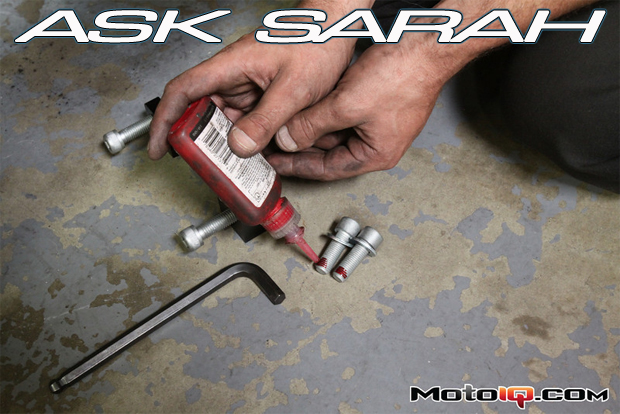
Ask Sarah: Red or Blue thread locker?
By Sarah Forst
I just recently completed Eibach lowering springs and anti-sway bars upgrade on my 08 Infiniti G37S Coupe. My question is when and where should I use threadlocker (red/blue) or Loctite? Different sources say different things, but is there a rule of thumb for applying these adhesives?
Thanks,
Kelvin
What a cool name for someone who is into cars! Or shop lights, at least… Permatex and Loctite are probably the two most well-known brands of thread locker. Most thread lockers use the same color identification to note the thread locker's strength so we'll stick with discussing those. You may also find thread locker adhesives sold under the names Pacer or Losi-Lok; some of these are more for hobby use but follow the same color ID. Thread locker adhesives bond and seal threaded fasteners, preventing them from shifting or loosening due to vibration and keep them from corroding. Red and Blue are both to be used before assembly. Red is heavy strength and provides a permanent seal. It should be used only on 10-25mm (3/8″ to1 inch) components you don't plan to remove such as frame bolts, wheel studs, crankshaft bolts, and transmission input and output shaft threads. Blue is medium strength and good for bolts between 6mm (1/4″) to 19mm (3/4″). It will hold but can be disassembled with hand tools for maintenance or repair. Blue is good for fasteners such as valve covers, water pumps, and oil pan bolts, intake manifolds, and pulleys.
 |
| Caliper bracket bolts are one of those things you don't want breaking loose in the middle of the track! |
Red is usually suggested for suspension components but some wrench monkeys (me included) seem to change these out more often than the average person. If you're just replacing some OEM pieces on a daily driver, Red will keep them locked tight. But if you like to swap out suspension like underwear (and hopefully that means often to you as well!), Blue will offer the strength you need but the flexibility you want.
Depending on the brand, thread locker adhesives are sold in varying temperature tolerances. Both Red and Blue thread lockers also come in different applications, including a semi-solid thread locker stick good for use on overhead applications. The thread locker sticks are pretty much the same formula but shouldn't be used on blind-hole applications where a fastener is being installed into a closed housing, since this requires applying the thread locker to both the male and female ends. If the thread locker was applied to only the male end and then torqued down, the pressure may force the thread locker back out, resulting in a crappy seal.
 |
| Loctite red and blue are the two most commonly used thread lockers. Be careful when using the red thread locker, especially on small fasteners, it is really hard to remove without heat. |
The rainbow of thread lockers isn't just a Red and Blue one. For really small bolts (up to 19mm) or easy removal, you may want to use Loctite Purple, a low strength thread locker. Purple works well with fasteners for headlamps, throttle body assembly, carburetors, or body panels. Blue, Red, and Purple are all for use before assembly. There is also thread locker Green, a high strength thread locker for use on 2.2mm (1/12″) to 12.7mm (1/2″) metal fasteners that have already been assembled, such as electrical connections, instrumentation screws, or distributor bolts. It can also be used to fill empty spaces in welds, casting, and powder metal parts. None of the Loctite thread lockers should be used on plastic parts, but there is a Permatex plastic thread locker that works on dashboards and consoles and other plastic pieces that require a little sealing.
 |
| Loctiite purple is used when low holding power is needed or for small fasteners. |
Thread lockers usually set in about 10 minutes and cure in 24 hours. Once cured, Red needs to be heated up to almost 500 degrees Fahrenheit before it is removable. If you do find something you used thread locker on that is not coming off as easily as you had hoped- Blue is even difficult to remove after some time- try heating it (to above 482 degrees F) with a soldering iron or torch, but be careful not to damage the fastener with the heat. Thread lockers are thermoset polymers. When heated, they become denser and more brittle, making it easier to break apart the bond. However, this process doesn't work with an ultra-high temp thread locker. Your best bet there is to annihilate the fastener and buy a replacement part! Finally, solvents will not help with disassembly but are good for cleaning up the remaining residue afterwards.
 |
| Maybe they won't chip when I'm working on cars now! |
Got a difficult tech question? Email Sarah at asksarah@motoiq.com



